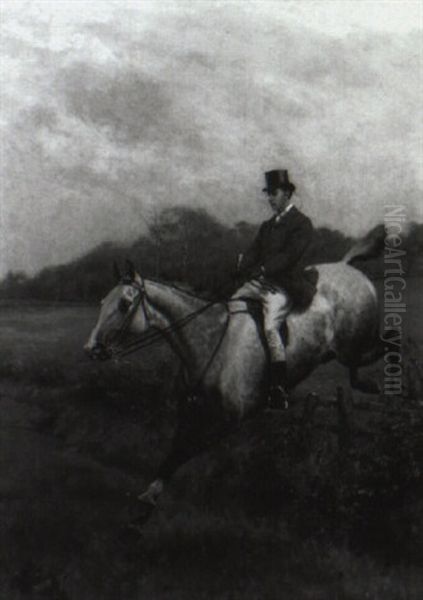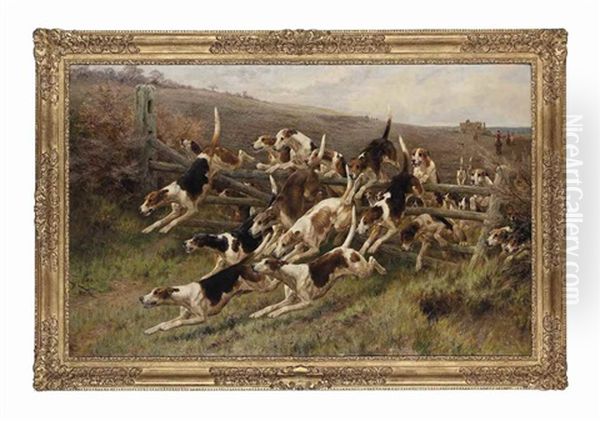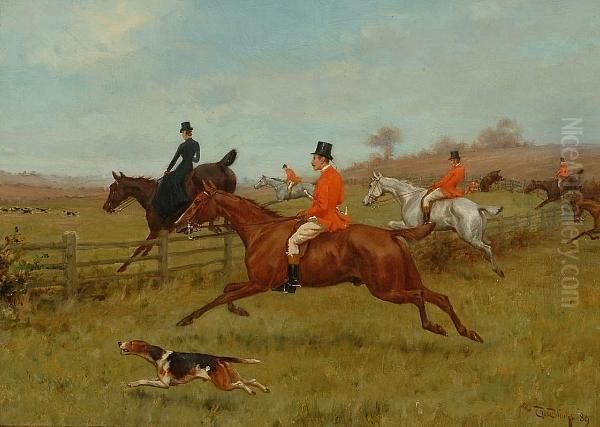Thomas Blinks stands as a significant figure in British Victorian art, celebrated primarily for his dynamic and anatomically precise depictions of sporting scenes, particularly those involving horses and dogs. Active during the latter half of the 19th century and the very beginning of the 20th, Blinks carved a unique niche for himself, achieving considerable recognition despite a lack of formal artistic training. His work captures the energy and spirit of the hunt, the racecourse, and the companionship between humans and animals, offering a vivid window into the pursuits and passions of the Victorian and Edwardian eras.
Biographical Details and Early Life
Pinpointing the exact birth year of Thomas Blinks presents a minor challenge for art historians, as sources offer conflicting information. Some records suggest he was born in Maidstone, Kent, England, in 1853. However, other reputable sources, including major auction houses and biographical dictionaries, more commonly cite his birth year as circa 1860. This discrepancy naturally leads to differing accounts of his age at death; he passed away in 1910, meaning he would have been either 57 (if born in 1853) or 50 (if born in 1860). The source material provided indicates an age of 57 or 60, adding another layer to the inconsistency, though the 1860 birth date is now more generally accepted in art historical circles.
Regardless of the precise date, his early life took a path away from the arts. He was initially apprenticed to a tailor, a practical trade likely chosen for stability. However, the young Blinks harboured artistic ambitions. This desire to pursue painting reportedly went against his father's wishes, suggesting a potential early conflict between familial expectation and personal passion. Ultimately, Blinks chose to follow his artistic calling, embarking on a path defined by self-determination and keen observation rather than academic instruction.
A Self-Taught Talent

Thomas Blinks is a notable example of a successful artist who honed his craft largely through independent study. Lacking formal art schooling, he developed his skills through rigorous self-teaching and, crucially, direct observation of his subjects. He became a frequent visitor to Tattersalls, the famous London horse auctioneers. There, he meticulously studied the anatomy, movement, and behaviour of horses, absorbing the nuances of their form and energy. This dedication to firsthand observation extended to dogs as well, particularly the breeds associated with hunting and sport, such as hounds and terriers.
This empirical approach formed the bedrock of his artistic practice. His ability to accurately render the complex musculature of a horse in full gallop or the focused intensity of a hound on the scent was not learned in a classroom but absorbed through hours of watching, sketching, and internalizing the essence of the animals he depicted. This foundation in real-world observation lent his work an authenticity and vitality that resonated with audiences familiar with these scenes.
Artistic Debut and Career Trajectory
Blinks made his public debut as an artist in 1881, exhibiting his work at the Dudley Gallery in London. This marked the beginning of a successful professional career. His talent was quickly recognized, and by 1882, he was elected a member of the Royal Society of British Artists (RBA), a significant accomplishment for a self-taught painter. This affiliation provided him with a platform and further validation within the London art world.
From 1883 onwards, Blinks became a regular and consistent exhibitor at the prestigious Royal Academy of Arts (RA). He continued to show his paintings there almost annually until his death in 1910. Exhibiting at the Royal Academy Summer Exhibition was a primary goal for most British artists of the period, offering unparalleled exposure to patrons, critics, and the public. Blinks's consistent presence there underscores the quality and popularity of his work. His sporting subjects found a ready audience among the landed gentry and enthusiasts of equestrian and field sports.
His growing reputation also led to portrait commissions, often featuring clients with their prized horses or dogs. While these commissions contributed to his income and standing, his primary fame rested on his dynamic sporting narratives. There is also a record of fellow artist Frederick Rodway seeking Blinks's expertise as an animal consultant, indicating the respect his anatomical knowledge commanded among his peers, even if extensive records of direct collaborations with other major painters are scarce.
Artistic Style: Victorian Realism and Animal Specialism

Thomas Blinks worked firmly within the tradition of British Victorian Realism. His style emphasized accurate representation, detailed observation, and a commitment to capturing the tangible world. However, his realism was not static or photographic; it was imbued with a sense of energy and life, particularly evident in his depictions of animals in motion. His brushwork, often described as free yet controlled, allowed him to convey the texture of animal coats, the strain of muscles, and the fleeting moments of action.
His deep understanding of animal anatomy, acquired through his studies at Tattersalls and elsewhere, was paramount. He excelled at portraying the unique gaits and postures of horses and dogs, capturing not just their physical forms but also conveying a sense of their temperament and "psychology." Whether depicting the explosive power of a racehorse nearing the finish line, the collective drive of a pack of foxhounds, or the alert stillness of a gundog, Blinks demonstrated an uncanny ability to get inside the skin of his subjects.
In the context of British art history, Blinks followed in the tradition of great animal painters like George Stubbs, whose scientific approach to equine anatomy set a high bar, and Sir Edwin Landseer, the dominant animal painter of the early and mid-Victorian era, known for his often anthropomorphized and sentimental portrayals. Blinks's work, while sharing a focus on realism with Landseer, generally avoided overt sentimentality, focusing instead on the athleticism and working nature of the animals. He can also be situated alongside other contemporaries specializing in sporting and animal art, such as John Frederick Herring Sr. and Jr., Heywood Hardy, Briton Rivière, John Emms, Wright Barker, Richard Ansdell, and the dog specialists George Earl and Maud Earl. While perhaps not reaching the revolutionary status of Stubbs or the widespread fame of Landseer, Blinks secured a respected position within this specific genre. Later figures like Sir Alfred Munnings would continue the tradition of British equestrian art into the 20th century.
Notable Works
Throughout his career, Thomas Blinks produced a significant body of work, primarily in oil paint. While comprehensive dating for all his pieces is not always available from the provided sources, several notable works are mentioned:
_Two Ducks Taking Flight_: This title suggests a focus on wildlife, showcasing Blinks's ability to capture animals in their natural environment with vibrant colour and detail, although a specific creation date is not provided in the source material.

_Outside the Horse Dealer's_: A title indicative of his interest in equine subjects and the world surrounding them, likely demonstrating his skill in capturing animal posture and perhaps the interaction between humans and horses. Again, a specific date is elusive based on the provided text.
_Tally Ho_: This painting, with its evocative title drawn from fox hunting, is described as an unusual hunting theme. The source material mistakenly links the date 1877 to this painting title via a book reference, so the actual creation date of Blinks's painting remains unconfirmed by the provided text but clearly falls within his known subject matter.
_For'ard on, for'ard on_: Exhibited at the Royal Academy in 1887, this work vividly captures the dynamic action of the hunt. The description mentions hounds leaping and navigating fences, with hunters following across the fields, showcasing Blinks's mastery of movement and complex composition involving multiple figures and animals.
_After a Day's Sport_: This painting is confirmed as being held in the collection of the Nuneaton Museum & Art Gallery. The title suggests a scene of rest or conclusion after the exertions of hunting or shooting, perhaps focusing on tired horses, hounds, or game.
These examples highlight the core themes of Blinks's oeuvre: the thrill of the chase, the beauty and power of horses, the loyalty and function of working dogs, and the landscapes of the British countryside that formed the backdrop for these activities.
Reputation, Anecdotes, and Minor Controversies
Thomas Blinks achieved considerable success during his lifetime. His paintings were popular among the affluent classes who participated in or admired field sports. This popularity naturally led to commissions and ensured a steady market for his work. His self-taught background, far from being a hindrance, perhaps added to his appeal, representing a triumph of natural talent and dedication. The anecdote about his father's initial disapproval serves to highlight his commitment to his chosen path.
While highly regarded for his technical skill and accuracy, particularly in anatomical rendering, some minor criticisms might be inferred. The intense focus on sporting subjects, while defining his niche, could be seen by some critics as limiting his artistic range compared to painters with broader thematic concerns. However, within his chosen field, his reputation was strong.
It is important to distinguish Thomas Blinks from later, more controversial artists like the anonymous street artist Banksy. The provided text contrasts Blinks's career, which seems free of major public scandals or deliberate provocations, with Banksy's headline-grabbing stunts and politically charged work. Blinks operated within the established structures of the Victorian art world – exhibiting at the RA, seeking patronage, and specializing in a genre favoured by the establishment. His "controversies," if any, were likely confined to mild critiques of subject matter or perhaps the personal hurdle of overcoming his father's initial objections.
Legacy and Collections
Thomas Blinks died in 1910, leaving behind a legacy as one of Britain's foremost sporting artists of the late Victorian and Edwardian periods. His work continues to be appreciated by collectors of sporting art, historians of the era, and those who admire skilled animal painting. His paintings capture a specific aspect of British social and cultural history with energy and precision.
His works are held in public collections in the United Kingdom. As mentioned, After a Day's Sport is housed at the Nuneaton Museum & Art Gallery. The source material also initially lists the New Walk Museum & Art Gallery in Leicester and Preston Manor in Brighton as holding his works, but later clarifies that specific confirmation for these venues was not found within its search results. It is plausible that works are held there or have been exhibited there, but verification requires further research beyond the provided text. Blinks's paintings also appear regularly on the art market, fetching respectable prices at auction houses like Christie's and Sotheby's, demonstrating their enduring appeal.
Conclusion
Thomas Blinks exemplifies the dedicated specialist within the broader landscape of Victorian art. Overcoming a lack of formal training through intense personal study and observation, he rose to become a respected member of the Royal Society of British Artists and a regular exhibitor at the Royal Academy. His paintings of hunting scenes, horse racing, and dogs are celebrated for their anatomical accuracy, dynamic sense of movement, and authentic portrayal of animal behaviour. While the exact dates of his birth remain slightly ambiguous, his artistic contributions from the 1880s until his death in 1910 are clear. He captured the spirit and energy of British sporting life with a skill and passion that continue to engage viewers today, securing his place as a key figure in the genre of sporting art.